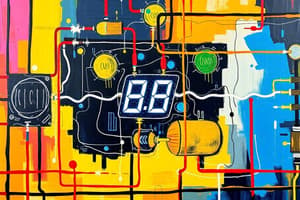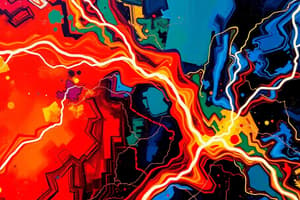Podcast
Questions and Answers
What is the main reason for the flow of electric current between two points?
What is the main reason for the flow of electric current between two points?
- The presence of a conductor between the two points
- The presence of a resistor in the circuit
- The potential difference between the two points (correct)
- The presence of a cell or battery
What is the primary function of a cell or battery in a circuit?
What is the primary function of a cell or battery in a circuit?
- To maintain a potential difference between its terminals (correct)
- To decrease the voltage in the circuit
- To increase the resistance in the circuit
- To block the flow of electric current
What is the consequence of connecting a dry cell to a torch bulb through copper wires?
What is the consequence of connecting a dry cell to a torch bulb through copper wires?
- The copper wires melt due to excessive heat
- The bulb does not light up
- The dry cell is drained of its chemical energy
- The bulb lights up due to the potential difference (correct)
What is a common source of potential difference or voltage?
What is a common source of potential difference or voltage?
What was the direction of electric current considered to be when electricity was first discovered?
What was the direction of electric current considered to be when electricity was first discovered?
Why do electrons in a metal wire move at random directions when not connected to a source of electricity?
Why do electrons in a metal wire move at random directions when not connected to a source of electricity?
What is the purpose of the chemical energy stored in a cell?
What is the purpose of the chemical energy stored in a cell?
What happens to the electrons in a metal wire when a source of electricity is connected?
What happens to the electrons in a metal wire when a source of electricity is connected?
What is the actual flow of electrons in a wire?
What is the actual flow of electrons in a wire?
What is the conventional direction of electric current?
What is the conventional direction of electric current?
Flashcards are hidden until you start studying




